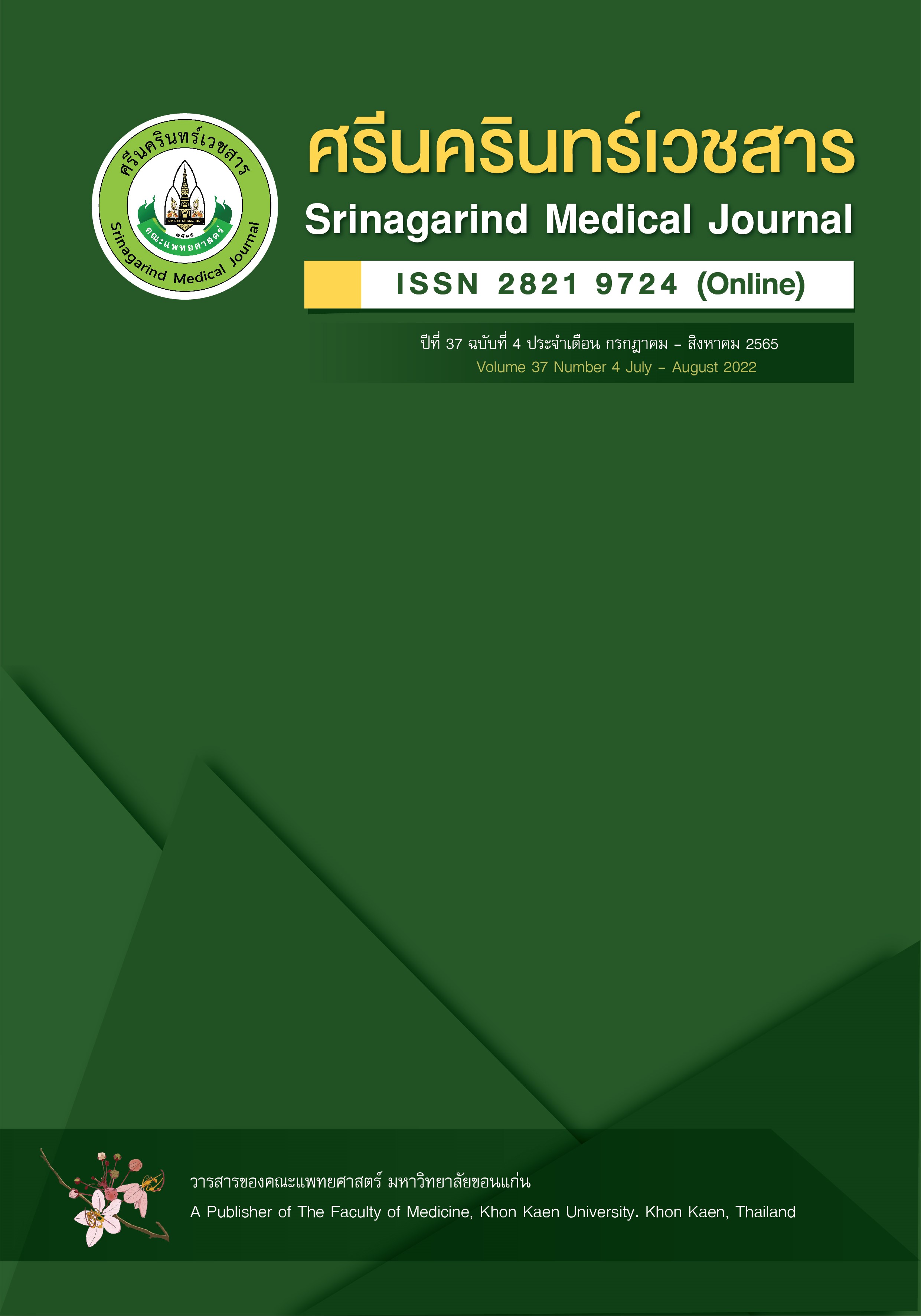ข้อมูลทางอาการ อาการแสดง และผลของการรักษาในผู้ป่วยเด็กโรคสมองอักเสบจากแอนติบอดีต่อตัวรับเอ็นเอ็มดีเอ(NMDAR) ในโรงพยาบาลศรีนครินทร์
คำสำคัญ:
โรคสมองอักเสบจากแอนติบอดีต่อตัวรับเอ็นเอ็มดีเอ, เด็ก, อาการ, ผลการรักษา, การเกิดโรคซ้ำบทคัดย่อ
หลักการและวัตถุประสงค์ โรคสมองอักเสบจากแอนติบอดีต่อตัวรับเอ็นเอ็มดีเอ (Anti-N-methyl-D-aspartate receptor, NMDAR) เป็นโรคสมองอักเสบจากภาวะแพ้ภูมิต้านทานที่พบได้บ่อยในเด็กแต่สามารถรักษาหายได้ การศึกษานี้มีวัตถุประสงค์เพื่อศึกษาอาการ อาการแสดง การตรวจวินิจฉัย การรักษา ผลการรักษา และปัจจัยที่อาจทำให้เกิดโรคซ้ำในผู้ป่วยเด็ก
วิธีการศึกษา การศึกษาย้อนหลังในเด็กโรคสมองอักเสบจากแอนติบอดีต่อตัวรับเอ็นเอ็มดีเอที่เข้ารับการรักษาในโรงพยาบาลศรีนครินทร์ ระหว่างเดือนมกราคม พ.ศ. 2559 – มีนาคม พ.ศ. 2563 จำนวน 10 ราย
ผลการศึกษา อายุเฉลี่ย 9.5 ปี (1-16 ปี)และร้อยละ 90 เป็นเพศหญิง อาการแสดงที่พบมากที่สุดในเด็กก่อนวัยรุ่นคือชัก ส่วนในวัยรุ่นพบมีปัญหาพฤติกรรม ผู้ป่วยทั้งหมดพบแอนติบอดีต่อตัวรับเอ็นเอ็มดีเอในน้ำไขสันหลังและเลือด แต่ไม่พบเนื้องอกในร่างกาย มี 3 ราย เป็นโรคสมองอักเสบจากเชื้อไวรัสมาก่อน เชื้อไวรัสที่พบได้แก่ Herpes simplex ในผู้ป่วย2รายและVaricella zoster 1ราย ผู้ป่วยทุกรายได้รับการรักษาด้วยยากดภูมิคุ้มกันขั้นแรก ร้อยละ 60 อาการดีขึ้นหลังได้รับยา และจากการติดตาม ร้อยละ 50 หายเป็นปกติ มี 4 รายที่ ได้รับยากดภูมิคุ้มกันขั้นที่สอง และ 2 รายเกิดโรคซ้ำ เมื่อเปรียบเทียบทางสถิติพบว่าระยะเวลาตั้งแต่มีอาการจนได้รับการรักษาของกลุ่มที่เป็นโรคซ้ำ (78.5 days, IQR 74-83) นานกว่ากลุ่มที่ไม่เป็นซ้ำ (19 days, IQR 13.5-28.5) อย่างมีนัยสำคัญทางสถิติ (p = 0.036).
สรุป อาการในผู้ป่วยเด็กโรคสมองอักเสบจากแอนติบอดีต่อตัวรับเอ็นเอ็มดีเอมีความแตกต่างกันตามช่วงวัย การติดเชื้อไวรัสนำมาก่อนอาจส่งผลให้ผลการรักษาไม่ดี และการรักษาล่าช้าอาจเป็นปัจจัยเกี่ยวข้องที่ทำให้เกิดโรคซ้ำได้
เอกสารอ้างอิง
Dalmau J, Tuzun E, Wu HY, Masjuan J, Rossi JE, Voloschin A, et al. Paraneoplastic anti-N-methyl-D-aspartate receptor encephalitis associated with ovarian teratoma. Ann Neurol 2007;61:25-36.
Armangue T, Titulaer MJ, Málaga I, Bataller L, Gabilondo I, Graus F, et al. Pediatric anti-N-methyl-D-aspartate receptor encephalitis- clinical analysis and novel findings in a series of 20 patients. J Pediatr 2013;162(4):850-6.
Glaser CA, Honarmand S, Anderson LJ, Schnurr DP, Forghani B, Cossen CK, et al. Beyond viruses: clinical profiles and etiologies associated with encephalitis. Clin Infect Dis 2006;43:1565-77.
Peery HE, Day GS, Doja A, Xia C, Fritzler MJ, Foster WG. Anti-NMDA receptor encephalitis in children: the disorder, its diagnosis, and treatment. Handb Clin Neurol 2013;119:1229-33.
Dalmau J, Lancaster E, Martinez-Hernandez E, Rosenfeld MR, Balice-Gordon R. Clinical experience and laboratory investigations in patients with anti-NMDAR encephalitis. Lancet Neurol 2011;10(1):63-74.
Fiser DH, Long N, Roberson PK, Hefley G, Zolten K, Brodie-Fowler M. Relationship of pediatric overall performance category and pediatric cerebral performance category scores at pediatric intensive care unit discharge with outcome measures collected at hospital discharge and 1- and 6-month follow-up assessments. Crit Care Med 2000;28:2616-20.
Zhang M, Li W, Zhou S, Zhou Y, Yang H, Yu L, et al. Clinical features, treatment, and outcomes among Chinese children with anti-methyl-D-aspartate receptor (anti-NMDAR) encephalitis. Front Neurol 2019;10:596.
Hung SKY, Hiew FL, Viswanathan S. Anti-NMDAR encephalitis in association with herpes simplex virus and viral and bacterial zoonoses. Ann Indian Acad Neurol 2019;22(1):102-3.
Chow FC, Glaser CA, Sheriff H, Xia D, Messenger S, Whitley R, et al. Use of clinical and neuroimaging characteristics to distinguish temporal lobe herpes simplex encephalitis from its mimics. Clin Infect Dis 2015;60:1377-83.
Schmitt SE, Pargeon K, Frechette ES, Hirsch LJ, Dalmau J, Friedman D. Extreme delta brush: a unique EEG pattern in adults with anti-NMDA receptor encephalitis. Neurology 2012;79:1094-100.
Titulaer MJ, McCracken L, Gabilondo I, Armangue T, Glaser C, Iizuka T, et al. Treatment and prognostic factors for long-term outcome in patients with anti-NMDA receptor encephalitis: an observational cohort study. Lancet Neurol 2013;12:157-65.
Hacohen Y, Deiva K, Pettingill P, Waters P, Siddiqui Ata, Chretien P, et al. N-methyl-D-aspartate receptor antibodies in post-herpes simplex virus encephalitis neurological relapse. Mov Disord 2014;29(1):90-6.
Grahn A, Studahl M. Varicell-zoster virus infection of the central nervous system-Prognosis, diagnostics and treatment. J Infect 2015;71(3):281-93.
Nosadini M, Granata T, Matricardi S, Freri E, Ragona F, Papetti L, et al. Relapse risk factors in anti-N-methyl-D-aspartate receptor encephalitis. Dev Med Child Neurol 2019;61:1101-7.
ดาวน์โหลด
เผยแพร่แล้ว
รูปแบบการอ้างอิง
ฉบับ
ประเภทบทความ
สัญญาอนุญาต
ลิขสิทธิ์ (c) 2022 ศรีนครินทร์เวชสาร

อนุญาตภายใต้เงื่อนไข Creative Commons Attribution-NonCommercial-NoDerivatives 4.0 International License.




